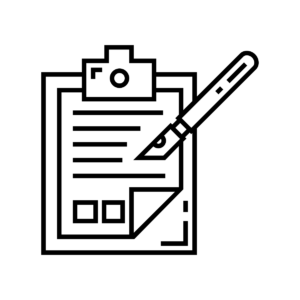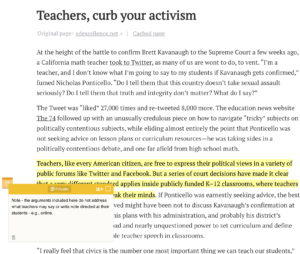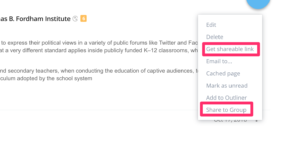A few years ago now, I began promoting a concept I called layering for learning. This effort combined my personal interest in developing and applying skills that others might call studying with my interest in technology. Of the various learning activities involved in education, I would argue that studying tends to be one of the most overlooked of education and yet what is conveniently described as studying in a formal education setting is the basis for the learning we do throughout our lives.
The distinction between studying and say reading can be quite important. For example, the concern that has been associated with reading on a device ignores the special benefits a device can provide in studying a text. Highlighting, note-taking, searching the large archive of the content that can be identified and expanded through highlighting and annotating a large body of content (a textbook), sharing efforts at personal understanding, searching for confirming or disconfirming evidence, and so one are powerful advantages for the use of technology in studying. Where can learners develop the skills in applying such tactics to digital or paper-based studying and who will help teach these tactics?
Layering for Learning is intended to target a carefully defined body of content; i.e., the content offered online which may or may not be designed as a learning resource. When I teach these ideas, I often associate it with the concept of teacher as designer to emphasize the distinction between content designed for education and the additional work educators should do to help learners with content not designed for instruction. This more general purpose content could be text-only, multimedia, or video. I am interested in this body of content because many educators value the authenticity of such sources and because there are important copyright issues associated with this content educators should recognize. We are also becoming aware that this type of content comes with added challenges as it must be vetted by a learner for factual accuracy. Add verification to the studying skills that must be acquired.
I define layering as a technique that adds elements on top of the content provided by an Internet source which does not actually modify that original source and retains all of the expectations the content creator might have had when providing this source online. For example, if a content creator assumed her/his content would be displayed with ads, the ads will be visible and responsive when a learner studies layered content. If a content creator relies on the frequency with which her/his content is viewing as a revenue metric for a sponsor, layering still requires that the server providing this content continues to send this content each time it is viewed. A layered experience actually combines information from two sources (the server sending the original content combined with additional elements from the layering service) that are experienced by the learner as if the combination originated from a single source.
The elements that can be layered vary from service to service but include highlights, comments possibly including links to other sources, questions, discussion prompts and shared replies, and diagrams or images. Again, depending on the service, these elements can be provided by an educator or generated by a learner. The elements can be shared socially or shared in a limited way to individualize the experience of providing analysis and feedback. Some services allow the tracking of the use of elements through a dashboard used by the educator.

I have developed both a Primer available from Amazon and free online video tutorials associated with several different free and commercial services that allow educators to utilize these services in their classrooms. The Primer is intended to explain how the layering tactics facilitate studying and provide examples. The tutorials are focused on how to set up and assign the layering services.
My focus on layering is restrictive to allow a focus for my writing, but the concepts apply to other tools such as Edji or Newsela that allow the application of similar tactics, but assume the educator has the rights to the content to the content that is being studied. The same goals of developing technology-based study skills can be developed within these environments.
So, if interest, I encourage your exploration of a few of my free tutorials. If these tutorials spark an interest, the $3 primer might be worth the investment.
89 total views





You must be logged in to post a comment.